Deja News
What conversations is Nick in ? Google for it ...

Nick Leverton
nick@leverton.org
![]()
There's more than one way to view this weblog; try one of these flavours.
 |
 |
 |
 |
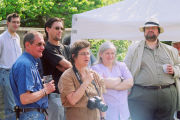 |
| SODAM, John G, Tony Gardner (a little bit of) | Purple Potter holds a hungry hippo | Keith Sheep (rear left), Iain, George, Min and Alex | Rosie | ?, Alex, Andy R, Min, Linda F-F and Robin III |
 |
 |
| The Declaiming of the Ode | Declamatory stance No. 37 (similar to 36, but with right arm extended instead of left). SODAM declaims, watched by Mike McT, John Gilliver, and Min. |
Cast list - all identifications of people in pictures welcome ! I know who most of you are (waves), but I'm not feeling up to typing it all in just now.
Uk.Media.Radio.Archers and what it is about.
Umra BBQ pictures: 2000 - 2001 - 2002 - 2004
Other Umra Barbeque pictures (also here).
Umra Links and other Archers Links.
![]() Google on The Archers
Google on The Archers
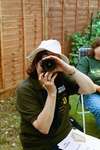 |
 |
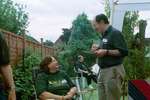 |
 |
 |
| Recursion: see recursion | Verily a Bit Of Fluff Extraordinaire :) | Vicky and ? | Kirsten and Benedict | "Life isn't all Woodbines and gin, you know." |
 |
 |
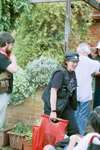 |
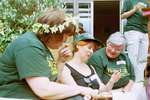 |
| "I've never seen it turn that colour before." | Min and Alex | A well dressed Weevil is never without her flour sack. | "The next one I write is going to be this heavy." |
From: Nick Leverton
Subject: Barticle physics
Date: Tue Sep 28 21:51:24 1998 GMT
Message-ID: <907015884snx@warren.demon.co.uk>
Newsgroups: uk.music.rave
In article <6u86hd$jjh$1@nnrp1.dejanews.com> barticle@my-dejanews.com writes:
>barticle physics :)
Barticle Physics refers to that branch of physics which concerns or is affected by the group of elementary particles known as "munterons" or "barticles". This includes the "definite barticle" or "barton" itself, which is a slepton, as well as a number of particles of similar if varying spin, orientation, et cetera, known as "indefinite barticles"; and the hardon-like group of "munterons". The interactions between these slepton and hardon particles are mediated by a hitherto-unknown nuclear force known as "munt". The previously known hardon particles are now generically referred to as "non-munterons".
As an example, let us look at an amorphous disorganised group of classical non-munterons. They may be in one of several different states: Sulky, Angry, Sad, Bored, Lonely or Frustrated. There will be little or no alignment between the states of neighbouring non-munterons. When they are stimulated by the application of sound energy, it is almost certain that they will exhibit widely differing reactions to it, and this in turn will lead to physical contacts and interactions between the non-munterons. These interactions may involve at the least the release of sound waves, and in cases of serious misalignment may also involve physical energy, which in the extreme can lead to one or both non-munterons being violently ejected from the group by the non-munteron mediator particle which is known as a "bouncer".
Consider now a similar amorphous disorganised group of munterons. Thanks to the mediation of the munt force, which is notable carried by small flat rounded particles generically called "munterases", it is highly likely that all munterons will be in the same state, known as Plur. Thanks to this alignment, when munterons and barticles are exposed to suitable ranges of sound frequencies, synchronised and co-ordinated motions will be observed, again often including physical contact, but in this case in a frictionless, synergistic mode rather than an antagonistic mode. If the contacts become too frequent, the infringing barticle or munteron will generally modify its modes of movement, or in severe cases may shift its spatial position slightly so as to reduce the level of interference to a more suitable level. Despite the far higher particle densities normmally found in a munteron group as compared to a non-munteron group, this will normally be achieved without the need for any outside mediation or any change in Plur alignment whatsoever.
Though it is still an open question whether barticles are subject to the munt force as they do not appear to interact with munterases, it is undeniably observable that they are normally to be found in the Plur state, and that they frequently interact with munterons, hence they undoubtedly belong in the same classification as other munterons.
Munterons are normally to be found in small groups of from two to a dozen particles. They will however naturally aggregate wherever suitable sources of sound waves are to be found. As noted above, densities in a munteron group may far exceed anything that can be sustained by non-munteron groupings. Though they can sometimes be observed exhibiting sound reactions singly, it is normal that once one commences, the alignment in Plur states and the action of the munt force will ensure that the reaction arena (quaintly called the "dance floor", for reasons that are unlikely to become clear again at the moment) quickly becomes crowded with well-aligned munterons.
There are two known extreme groupings of munterons. The first, muntronium, occurs when munterons are so closely packed that there is room between them only for the most minimal of sound reactions, the distance between barticle centres being between 0.5 and 1 times the munteron's normal free action radius. In this case there can still be free movement, because the Plur alignment guarantees an almost frictionless environment and, despite the density, each munteron is within reason still able to choose its own modes and degrees of movement. The second, known as bartronium, is a still denser packing, in which case there is no free space at all between munterons, and there is only room for a co-ordinated motion in the vertical plane. This state has never yet been observed naturally, and there is some doubt amongst researchers whether it will occur outside articifial conditions, as munterons generally prefer to have more than one degree of freedom.
Where munterons and non-munterons mix, the result depends on the proportions of each particle. If non-munterons are in the preponderance, then the munterons will not become bound to the sound source and are likely to be radiated from the group until they enter an environment more conducive to the Plur state. Interestingly, they are unlikely to return to the reaction site or "club" in which the experiment was carried out, which suggests some sort of quantum "memory" effect may be at work. Where munterons are substantially more numerous, however, it is likely that they will prevail. In this case one of two things may occur. Usually the non-munteron, unable to achive the sort of reaction which it is seeking, will leave the reaction site (mediation by a "bouncer" is rarely necessarily in well-run sites). Sometimes, however, the non-munteron may find that the Plur environment is, to use an unjustified but hopefully pardonable anthropomorphism, "congenial", and may itself become sensitive to the munt force and commence interacting with munterons and munterases in its own right. In this case, there is little alternative but to consider that the non-munteron has now become a munteron. Unfortunately the reaction rate is slow, otherwise it is likely that the entire universe would quickly be converted into munterons.
In summary, the study of munterons and barticles is a fascinating and rapidly expanding area of modern dynamics, and this researcher would heartily recommend that anyone interested in a career in this area should seek out a source of suitable munterase as soon as possible in order to commence their own investigations.
This article would not have been possible without the munterons and barticles of uk.music.rave, to whom all acknowledgements and massive respect are due for this researcher's own induction into the field.
N.J. Leverton, BA (Cantab(Pt.I))